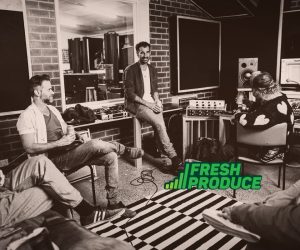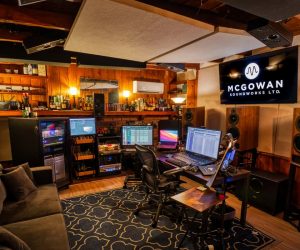
The Quick Mix: Danny Olesh
We caught up with Danny after a recent Tina Arena date to hear about his live sound philosophy.
Danny Olesh has been involved in Australian live music for over 40 years, spreading his talents across the entire spectrum of the industry including as a musician, sound engineer – of course, that’s why we’re here – and also as a designer and manufacturer of several ground-breaking software applications and even digital consoles. Everything to do with live music and studio recording is in his DNA. Danny’s Hungarian father travelled the world as a working musician, and currently Danny’s brother is the CEO of Waves – yes, that Waves, nothing to do with surfing – and is an accomplished sound engineer in his right, plus moonlights behind the drumkit.
The rigours of four decades in the music business don’t seem to have left a mark on Danny; he looks like he just graduated from high school, dammit, or maybe it was one of those virtual meeting filters you can apply on your webcam? He casually mentions just picking up his Seniors card.
BACK IN THE ’80s
His first real beginnings in the industry were in the 1980s and performances on stage as a keyboard player, admitting to be a tragic Duran Duran / Depeche Mode wannabe, when he embraced writing songs based around the fledgling computerised music scene but before there was any available software. Danny developed his own code, and this self-taught ability in programming was pivotal in his career well beyond inflicting cheesy ’80s arpeggios on the world. A stint in a few music stores as a specialist in synthesizers was augmented by working in recording studios where Danny was one of a few musicians who could seriously wrangle those early synths into doing their thing. His focus slowly turned more towards being on the other side of the mixing desk, and Danny started a modest, one-man PA hire company in Melbourne. It brought him into contact with emerging artists that have since become well known, such as Rick Price, CDB and Tina Arena, and Danny did the hard yards of touring long hours driving his truck, loaded with band gear, between gigs in different cities and states. On many occasions, he found himself putting together in-house or delivered PAs that were a complete mystery of patching and processing, and he just had to figure it out for himself – many of today’s veteran sound guys will be familiar with that learning curve.
This period coincided with Danny continuing to dabble in software design and he wrote a program for radio stations to schedule, organise and play music from a PC hard drive. This kind of software was already available, except it was hugely expensive. Danny successfully introduced his programming into nearly 30 radio stations. By default, this required Danny to import PCI sound cards into the country to install in the computers, which in turn led to teaming up with John Fuller and establishing Sound and Music, now a major importer and distributor of a wide range of musical gear. Through liaising with the overseas manufacturers and having plenty of input into the design of the equipment to better suit the market, Sound and Music became an exporter as well, and it gave Danny the opportunity to fulfil a long-held ambition – to build his own mixing desk. After several years of research, design and investment with a great team of people from around the world, the company sold the prototype to Harman and it became the basis of the very popular Soundcraft UI series of consoles. While Danny handed over the keys to the IP and everything with it, he remained involved as a support specialist and consultant.
So, whenever someone taps Danny on the shoulder when he’s behind a mixing desk and they ask, “Do you really know what all those knobs and buttons do?” he can confidently reply that he’s got a rough idea.

Danny Olesh mixing Tina Arena at Home of the Arts, Gold Coast.
BACK BEHIND THE DESK
Around 2016, Danny’s priorities returned to what he loves doing the most – being behind a console and mixing live music. He confides that it required something of a catch-up crash course in operating digital consoles, especially as his clientele were some of the biggest acts like Tina Arena, Guy Sebastian and others who drew large crowds, and the channel counts were right up there. Danny is the first to say it’s a team effort and he loves to surround himself with people who are similarly passionate and inspired by live concert projects.
The Danny Olesh First Law of Sound Engineering is learning how to listen. Listening to what the band is trying to do, and listening to what each musician is doing to contribute to that overall sound. It’s not a case of shaping all the noises coming off stage into some kind of perfect representation of how each instrument should sound. Rather, it’s about reinforcing what the musicians are creating. In other words, identifying the sound and vibe of the band.
Next, sound engineering is a visual role. Danny is constantly scanning the stage, watching what’s happening, maybe looking for instruments that can’t be heard and instantly investigating why, or picking up cues that someone is going to launch into a solo – or maybe launch themselves into the crowd. Whenever possible, having a close relationship with the artist is important, and again when it can be done, familiarising yourself with their body of work.
These are all things primary to touching any faders. Then comes Danny’s speciality – the hands-on mixing. He’s adamant about ‘creating space’ within his mixes, especially when it’s an important vocal. Of course, all vocals are important, but he’s often been asked to work in environments when that isn’t easy to achieve. Orchestras with guest singers, for example, can be a new experience for everyone on stage, and producers recognise Danny’s ability to have all the many elements faithfully represented in the mix and still have the vocals sitting comfortably in a zone of their own.
IT’S ALL GOOD
“All the digital consoles these days are good. You can get a result with all of them.”
Danny has operated almost every flavour of digital mixer there is and enjoys the wealth of plugins, effects and routing option they all offer. At the same time, he isn’t shy of adding third-party plugins too, particularly if something brings a unique quality that’s otherwise missing. He’s not a plugin ‘nerd’ who loads a swathe of effects just because he can (and having his brother driving the bus at Waves, you can imagine Danny has access to plenty of goodies), but he will employ plugins that having something interesting or exciting to add, or that provide a solution. Dynamic EQ remains a favourite.
It prompted the inevitable comparison to analogue desks and the days of yore.
“Analogue desks are different, they sound different, and they’re amazing.” The simplicity of analogue desks and the voicing of the EQs still have their appeal. But then Danny adds, “people’s memories of how good it used to be with W-bins and 45/60s and analogue desks… it’s not true. It wasn’t like that.”
He’s not so sentimental when it comes to those monster rigs of the past. The versatility and multiple functions of any decent digital desk today far outstrips any nostalgic memories of analogue desks and trap boxes. Plus, most modern equipment can be picked up and carried without making a chiropractor appointment afterwards. That’s a win.
ON MONITORS & MONITORING ENGINEERS
“Obviously, things have become a lot easier with the growing prevalence of IEMs. Ideally, I don’t have any guitar amplifiers on stage at all, but that’s rarely possible. I’ll always spend time helping a band to set up IEMs and whatever they need, because ultimately getting that right is going to help me do my job. These days, with snapshots, saved scenes and presets in digital (monitor) desks, you can get everything up and running in maybe 15 minutes.”
As with the musicians, a good relationship with a monitor engineer is very important and Danny always works towards that.
people’s memories of how good it used to be with W-bins and 45/60s and analogue desks… it’s not true. It wasn’t like that

The JBL VTX system for the Tina Arena date at the Home of the Arts (HOTA) on the Gold Coast.
NUTS & BOLTS & MICS
Danny acknowledges that a lot of musicians have their preferred microphones for various applications, so he doesn’t exactly enter a gig with a suitcase of mics. Still, for toms he uses sE Electronics V Beats, an inner kick mic is an sE Electronics BL8, and for vocals has the sE V7 capsule on all the wireless handhelds. “Especially for female singers and Tina in particular. The V7 capsule works fantastic.”
(Full disclosure: Sound and Music distributes sE microphones.)
SO WHAT DOES HE BRING TO A GIG?
It was initially surprising – then it made sense as Danny explained – that less and less, he feels any need to add to an existing in-house PA. Apart from perhaps bringing in some extra subs, most venues have more than adequate systems to cater for any act on stage. Over the years, Danny has accumulated a sizeable collection of show files for lots of different consoles and with the press of a ‘Load Show’ button he’s halfway there in seconds. However, he frequently encounters venue PAs that have somehow, over time, lost the best configuration possible and Danny will roll up his sleeves and tweak it back to life – often to gasps of “We’re not allowed to touch that!”
One preference though is Danny will always run subs from an auxiliary send. “I like my subs explosive when I need it.” Hopefully he doesn’t mean that literally.
JBL VTX AT HOTA
Which brings us to the complete opposite situation – a recent Tina Arena show of her ‘Love Saves’ tour at the Home of the Arts (HOTA) on the Gold Coast. Initially, production logistics were to be shared across multiple acts, but for reasons unknown the other bands pulled the plug leaving Tina as the only act on the bill. Danny saw a great opportunity to test drive the latest JBL VTX system and got in touch with MadisonAV’s Pete Kubow to see if it was possible. VTX distributor, MadisonAV, was more than accommodating. After getting some venue specs from Danny, Pete Kubow came up with some drawings which Danny then sent on to John Hall, his systems technician of many years. With a bit of back and forth, a tweak here and a twerk there, a VTX system was configured and put in place.
“It sounded great – and Tina is the sort of performer who is so talented and powerful in her delivery, she’ll instantly reveal any shortcomings in any PA. It had beautiful top end, a nice spread, no issues at all. It was very, very good. It was raining (this is an outdoor venue), there was a bit of wind… all kinds of things that might have affected the sound, but it was still fantastic. The VTX can compete with any PA in its league.”
BLEEDING EDGE EXPERIENCE
Danny Olesh represents the best of both worlds when it comes to sound engineering – he brings a wealth of experience with his 40 years in the business, and he’s at the cutting edge of what’s new and exciting in the industry. He strikes you as someone you could chat with for hours and the conversation will always be fascinating.
Including how the hell he got that Seniors card.






















